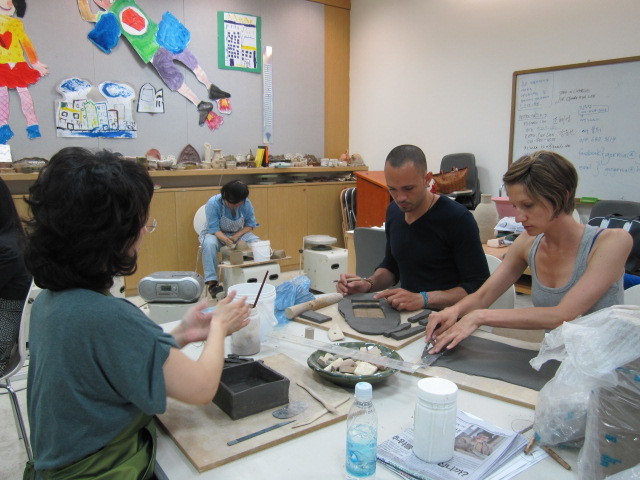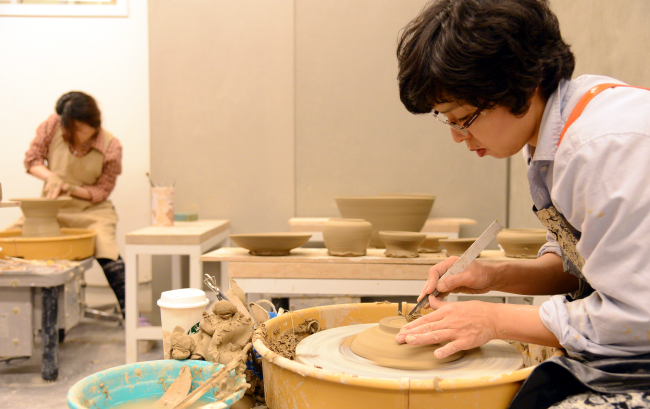From pottery, painting to integrated art classes, making art helps one discover talents, inspiration in life
 Participants take part in a pottery class for foreigners at Seoul Museum of Art. (Seoul Museum of Art)
Participants take part in a pottery class for foreigners at Seoul Museum of Art. (Seoul Museum of Art)
Museums and galleries are not just places to view exhibitions.
They could be a place for finding undiscovered talents and a source of inspiration in an otherwise routine life. And traditional hands-on art classes are evolving to meet the needs of a diverse audience such as multicultural and expatriate families.
From public museums such as the National Museum of Contemporary Art, Korea, Seoul Museum of Art and Seoul Arts Center, to private museums like Yido Gallery and Youngen Museum of Contemporary Art, various art institutions are offering more diverse programs.
Among various art classes, pottery classes are one of the most popular hands-on programs.
 Students at the Korean craft class held at Youngeun Museum of Contemporary Art (Youngeun Museum of Contemporary Art)
Students at the Korean craft class held at Youngeun Museum of Contemporary Art (Youngeun Museum of Contemporary Art)
 Participants work on the pottery wheels during a pottery class at Yido, a ceramic art gallery in Gahoe-dong, Jongno, Seoul, on Thursday. (Ahn Hoon/The Korea Herald)
Participants work on the pottery wheels during a pottery class at Yido, a ceramic art gallery in Gahoe-dong, Jongno, Seoul, on Thursday. (Ahn Hoon/The Korea Herald)
Yido, a ceramic gallery opened in 2010 in Gahoe-dong, Jongno-gu, is popular among those who want to pursue pottery making beyond the amateur level.
“Some of my students go to a graduate school of ceramic art after finishing courses here. Some learn pottery as a hobby for life after retirement and some feel the joy of making ceramic wares and give them as gifts to their friends and families,” said Cho Hae-taek, deputy general manager of Yido’s academy.
Starting with 23 students in 2010, the pottery academy expanded to accept 140 students, including celebrities and professionals. The 10-member classes, which are held Monday to Saturday, are led by ceramic artists and divided into three courses ― handcrafts, pottery wheel and professional-level courses.
“It relieves stress and calms your mind. And you can feel great achievement after hours of concentration when making the pottery,” said Cho, who recently gave technical advice to a team of an upcoming TV drama based on a story about pottery makers.
“No one knows the real charm of pottery until they really try. One thing is that impatient people can build patience,” Choi added.
Hands-on art classes also offer a chance to make friends with other students.
Seoul Museum of Art holds a pottery class for expatriates in Korea to offer them a chance to mingle with other expats and Koreans and experience Korean pottery techniques.
“It’s a very interesting class to learn how Koreans do their pottery and to meet up with other foreigners. I think this is a good way to welcome foreigners to settle and learn more about Korean culture,” said Susanti Wardjojo from Jakarta, one of the 20 attendees at the orientation for the pottery class on Wednesday.
“I came with Susanti who introduced me to the pottery class. It’s my first time joining an art class, but I would like to experience Korean pottery techniques and meet other people,” said Yuko Morahan, a Japanese woman living in Korea since last August.
The free eight-week course, which runs from this week to June 26, accepts both foreigners and Koreans, and teaches basic techniques required for making pottery from hand-building techniques, decoration, hand painting and glazing and firing.
Registration for the highly popular class opens in April each year at the museum’s website, sema.seoul.go.kr.
Painting classes also attract art lovers and are loved by both children and adults. Traditional painting classes feature oil, acrylic painting and pencil drawing and sketches. Seoul Arts Center boasts a variety of painting classes, but one of the most popular classes is the contemporary painting class, according to the education department.
The class teaches ways to visualize abstract concepts and psychological condition through abstract and figurative painting techniques.
Art for multicultural students
With the numbers of expatriate and multicultural families increasing in Korea, museums have come up with various art programs that offer children from multicultural families a chance to learn and experience art.
The National Museum of Contemporary Art, Korea conducts a group art program for children of elementary school age every Saturday from March to November. Under the theme of diversity, children make sculptures and installations using different materials, inspired by Nam June Paik’s video installation “The More The Better,” a work composed of 1,003 monitors, installed in the center hall of the museum.
“Children will experience how diversity makes harmony through craft-making programs that meet the theme of Nam June Paik’s work,” said Cho Jang-eun, a senior educator of department of the education and residency program at the NMOCA.
The museum also runs a group program for Korean children of elementary school age to help them understand cultural diversity through activities related to a pot, a metaphor of a cultural mix. To apply for the programs, visit www.moca.go.kr.
Seoul Arts Center in Seocho-dong, southern Seoul, also offers art classes for multicultural children and their mothers. The Sunday classes are integrated art education programs where children can experience activities that combine different fields of art such as music and art, and literature and art. For mothers, the museum provides a craft-making program, including Korean traditional bojagi and flower decoration at the same time when the children’s class is held.
“Moms waiting for their children for two hours can participate in the class and discover their artistic side in making crafts,” said Choi Jin-suk, director of the education program at Seoul Arts Center.
By Lee Woo-young (wylee@heraldcorp.com)
http://www.koreaherald.com/view.php?ud=20130510000711